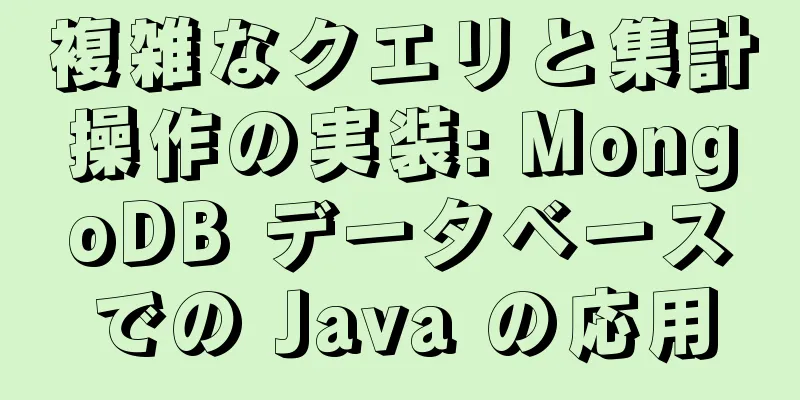複雑なクエリと集計操作の実装: MongoDB データベースでの Java の応用

|
MongoDB データベースに Java を適用すると、複雑なクエリや集計操作を実装できるため、開発者は強力なデータ分析および処理機能を利用できるようになります。以下では、Java を使用して複雑なクエリと集計操作を実行する方法について説明し、その使用方法を示すサンプル コードをいくつか示します。 1. 複雑なクエリJava は、MongoDB Java ドライバーを使用して、さまざまな種類の複雑なクエリを実行できます。以下に、一般的なクエリ操作とそれに対応する Java コードの例を示します。 1. 単一のドキュメントをクエリします。 2. 複数のドキュメントをクエリする: 3. ネストされたドキュメントをクエリする: 4. 配列フィールドをクエリする: 2. 集計操作Java は MongoDB の集計パイプラインを使用して複雑な集計操作を実行できます。以下に、一般的な集計操作とそれに対応する Java コードの例を示します。 1. 単純な集計: 2. 集計計算: 3. 集計ソート: Java を使用して MongoDB データベースに複雑なクエリと集計操作を実装すると、開発者はデータをより適切に処理および分析できるようになります。 MongoDB の Java ドライバーを使用すると、単一ドキュメント クエリ、複数ドキュメント クエリ、ネストされたドキュメント クエリ、配列フィールド クエリなど、さまざまな種類のクエリ操作を簡単に実行できます。さらに、MongoDB の集計パイプラインを使用すると、単純な集計、集計計算、集計ソートなどの複雑な集計操作を実行できます。これらのテクノロジーを学習して適用することで、開発者は Java と MongoDB のパワーを最大限に活用し、効率的で信頼性の高いデータ処理および分析システムを構築できます。 |
>>: 信用デフォルト予測モデリングでは、ランダムフォレストが 91.1% でトップに!
推薦する
上位 10 の古典的なソートアルゴリズムを理解するのに役立つ 20 枚の写真
[[433768]]ソートアルゴリズムのトップ10のアイデアのまとめ手書きのソートアルゴリズムは面接...
GPUが急成長を遂げるGenAIの時代において、AMDはNvidiaのCUDAソフトウェアの堀を超えつつある
今日、生成 AI (GenAI) について話すとき、GPU とそれに伴うパフォーマンスおよびアクセシ...
ビル・ゲイツ:人工知能に国境を簡単に引いてはいけない
[[260361]]新華社によると、ビル&メリンダ・ゲイツ財団の共同議長ビル・ゲイツ氏は最近スタンフ...
「クローズドループ」に向けての運転 | LMDrive: LLM に基づく初のクローズドループ エンドツーエンド自動運転
この記事は、Heart of Autonomous Driving の公開アカウントから許可を得て転...
トピックモデルに適した定量評価指標を見つけるにはどうすればよいでしょうか?これは人気のある方法の要約です
LDA (潜在的ディリクレ分布) や Biterm などの統計トピック モデルを適用することで、大量...
Google、人工知能をより有効活用できるよう複数のAIツールをリリース
Google は今週開催された Cloud Next カンファレンスで、さまざまな機械学習ツール、顧...
Yandexとロシア郵便が配達ロボットサービスを開始
外国メディアの報道によると、ロシアの検索エンジン会社ヤンデックスとロシア郵便は最近、モスクワのいくつ...
専門家:TikTokのアルゴリズムはユニークではないが、購入者はそれを自ら開発することを待ちきれない
2018年にバイトダンスがカラオケアプリ「Musical.ly」を買収し、TikTokとしてブランド...
強力なJavaScriptによりスノーフレークアルゴリズムが実現
[[353520]]この記事はWeChat公式アカウント「妹の味」から転載したもので、著者は妹が飼っ...
皇帝の側室選定と推薦アルゴリズムの仕組み
[[393467]]この記事はWeChatの公開アカウント「Shu Shixiong」から転載したも...
AIは教育分野にどのように貢献できるのでしょうか?
調査機関Markets&Marketsの予測によると、2023年までに世界の教育業界における...
新しいAIプログラミング言語はディープラーニングを超える
MIT の研究者チームは、人工知能の分野を初心者にとってよりアクセスしやすいものにするとともに、専門...
「自然言語処理」とは何ですか? 具体的に何を「処理」するのですか?
[51CTO.com からのオリジナル記事] 「自然言語処理」(NLP) は、近年テクノロジー コ...
LiDARとTexas Instrumentsチップを搭載した最新のL3自動運転アーキテクチャの分析
画像出典: インターネット来年発売されるヒュンダイG90とGV80は、ヒュンダイのL3自動運転モデル...









